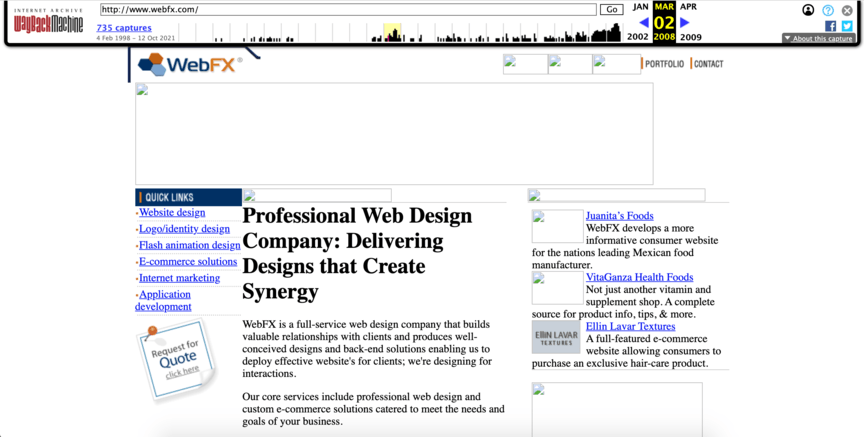How to Use a Web Cache Viewer to View a Cached Page
Websites change every day. Sure, there are still some sites out there that are eternally frozen in 2010, but most websites — or at least, most business websites — change over time. They put out new content, create new pages, and update their layout to look fresher and more appealing.
Still, there may be a time when you want to go back and see what a page used to look like. When that happens, you may think it’s impossible without a time machine — but it’s not. All you have to do is go back and find a cached version of the page.
But what is web caching, and how can you view a cached page? We’ll answer both of those questions below as we explain how to use a web cache viewer.
Read on to learn more, and then subscribe to Revenue Weekly — our email newsletter — for more digital marketing tips from the agency with over 20 years of experience!
For even more digital marketing advice, sign up for the email that more than 190,000 other marketers trust: 
Revenue Weekly!
Sign up Today!
What is web caching?
Caching refers to the process of saving old versions of web pages.
Let’s say your website looks a certain way one day, and then the next day, you roll out a redesigned version with a whole different layout. You could still view the cached version of your site to see what it looked like before.
In most cases, you’d want to view the most recent version of a page, but sometimes you might even want to go back several caches to find the one you’re looking for. Whatever the case, caching makes it possible.
When might you want to view a cached page?
There are several situations where you might want to pull up a cached version of a page. Here’s a brief overview of the most common scenarios.
1. A page is down
One of the main times you would want to dig into an Internet cache is when a page on a website is down. This could happen for various reasons, including:
- A traffic spike has slowed the page down so much that it won’t load
- The page has been removed from the website
- The page is under maintenance
- The page requires a password where it didn’t previously
In any event, if a page is down that you could view previously, you can still see it by pulling up a cached version.
Keep in mind that you can’t necessarily use any of the functions on a cached page — think of it as a “read-only” version of the page. However, if you just want to view the information there, it can be a valuable resource.
2. Your site is running slowly
Loading a cached page is much faster for Google than loading the current version of a page. That means that when you visit a site for the first time, Google will load the current version — but on subsequent visits, it will use the most recent cache.
In this way, caching pages on your website can drastically improve your page load speeds. When your pages load faster, users will be more inclined to stick around, meaning caching is a way to improve your site traffic and search engine optimization (SEO).
3. You want to look back in time
Sometimes you might want to view a cached page for no reason other than curiosity. If you go far enough back in the archives, you can find versions of a page from years earlier.
This is the closest you can get to hopping in a time machine and traveling back to a site’s past. Maybe you want to see what the content of the page said a long time ago, or maybe you just want to marvel at the old visual design.
Whatever the case, an Internet cache allows you to see pages as they were a long time ago.
How to use a web cache viewer
Now that we know what web caching is and why you might want to use it, how can you view cached web pages? The solution is to use a web cache viewer, or a web cache tool that lets you pull up cached pages.
These web cache tools aren’t complicated or hard to access — on the contrary, they’re extremely accessible! Just try out one of the options below to start viewing previous versions of pages.
1. Find cached pages in Google search results
One of the simplest ways to view a cached version of a page is to pull it up in Google search results. When you find a page in search results, look at the URL listed there. To the right of it, you’ll see a drop-down arrow or three dots.
When you click on that symbol, you should see a button somewhere that says “Cached.” By clicking on that, you can view the most recent cached version of that page.
2. Use the address bar
Another method for viewing cached pages is to use the address bar in your browser. Copy the URL into the address bar as normal, but then type “cache:” at the very beginning. So, if you wanted to visit the most recent cache for webfx.com, you’d type “cache:webfx.com.”
This is the easiest method to use if you already have the exact URL for the page you want, since you can just paste it in and type “cache” to find the cached version in seconds.
3. Visit the Wayback Machine
As helpful as the previous two methods are, they only allow you to see the most recent version of a page. If you want to go back further in time, the best method is to use the Wayback Machine.
The Wayback Machine is a web cache tool that’s been collecting snapshots of websites across the Internet for years. By typing a URL into its search bar, you can choose from multiple previous snapshots to see how the site used to look.

4. Try a Chrome extension
Finally, there are a few Chrome extensions that can help you access Internet caches. Web Cache Viewer, in particular, is a useful tool that will let you right-click on links to view their cached versions in either the Wayback Machine or the Google Cache.
This extension offers a quick and easy way to access cached versions if it’s something you plan to do regularly.
We don't just want to tell you about the beautiful work we do
We Want to Show You!
We’ve built over a thousand
View Our Past Work
Websites in industries like yours
Let WebFX help you optimize your website
Want help caching your website and redesigning it to attract more traffic? WebFX would love to help! We offer top-tier web design services aimed at making your site look more appealing and function more smoothly for users.
When you partner with us, you’ll get help caching your site and more. You’ll also receive a dedicated account representative to keep you in the loop about everything we do for your site.
To get started with us, just call 888-601-5359 or contact us online today!
The post How to Use a Web Cache Viewer to View a Cached Page appeared first on WebFX Blog.